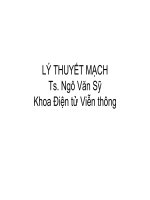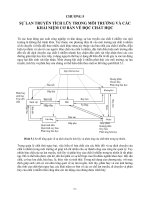Bài thuyết trình bằng tiếng anh - Nền kinh tế mở
Bạn đang xem bản rút gọn của tài liệu. Xem và tải ngay bản đầy đủ của tài liệu tại đây (1.09 MB, 26 trang )
CHAPTER 18
OPEN-ECONOMY MACROECONOMICS
BASIC CONCEPTS
Student: LÊ HỒ MINH GIANG
OPEN-ECONOMY MACROECONOMICS: BASIC CONCEPTS
Does not interact with other economies in
the world
Company Logo
OPEN-ECONOMY MACROECONOMICS: BASIC CONCEPTS
Open economy: interacts freely with other economies around the world
Buy & sell
Company Logo
Goods & services
Capital assets
OPEN-ECONOMY MACROECONOMICS: BASIC CONCEPTS
1. The international Flows of Goods and Capital
2. The Prices for International Transactions: Real and Nominal Exchange Rates
3. A First Theory of Exchange-Rate Determination: Purchasing-Power Parity
OPEN-ECONOMY MACROECONOMICS: BASIC CONCEPTS
1. The international Flows of Goods and Capital
1.1. The Flow of Goods: Exports, Imports, Net Exports
1.2. The Flow of Financial Resources-Net Capital Outflow
1.3. The Equality of Net Exports and Net Capital Outflow
1.4. Saving, Investment, and their Relationship to International Flows
OPEN-ECONOMY MACROECONOMICS: BASIC CONCEPTS
1. The international Flows of Goods and Capital
1.1. The Flow of Goods
Domestically produced goods $ services
that are sold abroad
Goods and services that are produced
abroad and sold domestically
OPEN-ECONOMY MACROECONOMICS: BASIC CONCEPTS
1. The international Flows of Goods and Capital
1.1. The Flow of Goods
Net exports (Trade balance) = Exports - Imports
Trade deficit
Balanced trade
Trade surplus
OPEN-ECONOMY MACROECONOMICS: BASIC CONCEPTS
1. The international Flows of Goods and Capital
1.1. The Flow of Goods
1. The tastes of consumers for domestic & foreign goods
2. The prices of goods at home & abroad
Factors
influence
exports,
3. The exchange rates at which people can use domestic curency to buy foreign currencies
imports & Net
exports
4. The incomes of consumers at home & abroad
5. The cost of transporting goods from country to country
6. Government policies toward international trade
OPEN-ECONOMY MACROECONOMICS: BASIC CONCEPTS
1. The international Flows of Goods and Capital
1.2. The Flow of Financial Resources: Net Capital Outflow
NCO = Purchases of foreign asests _ purchases of domestic assets
by domestic residents
by foreigners
Foreign direct investment
Capital is owned & operated
(FDI)
by a foreign entity
Two forms of the flow of
capital abroad
Foreign porfolio investment
(FPI)
Is financed with foreign money
but operated by domestic
residents
OPEN-ECONOMY MACROECONOMICS: BASIC CONCEPTS
1. The international Flows of Goods and Capital
1.2. The Flow of Financial Resources: Net Capital Outflow
NCO = Purchases of foreign asests _ purchases of domestic assets
by domestic residents
by foreigners
How does these activities affect the US. NCO?
1. A US. resident buys stock in Telmex, the Mexican
telecommunications company.
Increase
2. A Japanese resident buys a bond issued by the US.
government
Decrease
OPEN-ECONOMY MACROECONOMICS: BASIC CONCEPTS
1. The international Flows of Goods and Capital
1.2. The Flow of Financial Resources: Net Capital Outflow
NCO = Purchases of foreign asests _ purchases of domestic assets
by domestic residents
by foreigners
Possitive (+)
Negative (-)
OPEN-ECONOMY MACROECONOMICS: BASIC CONCEPTS
1. The international Flows of Goods and Capital
1.2. The Flow of Financial Resources: Net Capital Outflow
The real interest being paid on foreign assets
The real interest being paid on domestic assets
Factors influence NCO
The perceived economic and political risks of holding assets abroad
The government policies that affect foreign ownership of domestic asset
OPEN-ECONOMY MACROECONOMICS: BASIC CONCEPTS
1. The international Flows of Goods and Capital
1.3. The equality of Net Exports and Net Capital Outflow:
Net exports (NX) = Net Capital Outflow (NCO)
Example: You sell your
products to Japanese
consumer for 1000 yen
NX of VN ?
Export activity => VN NX increase
1. Use the yen to purchase another Japanese assets =>
NCO ?
rise
2. Use the yen to purchase another Japanese goods => NX ? NCO?
Import increase => NX = 0
=> No impact on NCO
OPEN-ECONOMY MACROECONOMICS: BASIC CONCEPTS
1. The international Flows of Goods and Capital
1.4. Saving, Investment, their Relationship to the International Flows
When a Vietnamese citizen saves 1 VND of his income, that VND can be used to
finance accumulation of domestic capital or it can be used to finance the
S = I + NX = I + NCO
purchase of capital abroad.
National saving
Buy stock issued
by Vinamilk
Mutual Fund
Domestic investment
Buy stock issued
by Toyota
NCO
OPEN-ECONOMY MACROECONOMICS: BASIC CONCEPTS
2. The Prices for International Transactions: Real and Nominal Exchange Rates
2.1. The nominal exchange rate: the rate at which a person can trade the currency of one country for the currency
of another.
Ex: 80 yen per dollar = 1/80 dollar (0.0125 dollar) per yen
$1 = 10 pesos Mexico
1 peso = ????
$0.10
OPEN-ECONOMY MACROECONOMICS: BASIC CONCEPTS
2. The Prices for International Transactions: Real and Nominal Exchange Rates
Bath
1 Peso Philippine
625.800
1 USD
26772
1 bath
478.09
1 EUR
23300
EUR
Peso
USD
OPEN-ECONOMY MACROECONOMICS: BASIC CONCEPTS
2. The Prices for International Transactions: Real and Nominal Exchange Rates
2.1. The nominal exchange rate:
Appreciation/ Depreciation: an increase/ decrease in the value of a currency as measured by the amount of
foreign currency it can buy.
A currency appreciates/ depreciates => strengthen/weaken
2018: 1USD = 22.498 VND
2019: 1USD = 23.300 VND
The dollar/ VND is said to appreciate/depreciate
(strengthen/weaken)
OPEN-ECONOMY MACROECONOMICS: BASIC CONCEPTS
2. The Prices for International Transactions: Real and Nominal Exchange Rates
2.2. The real exchange rate the rate at which a person can trade the goods and services of one country for the
goods and services of another.
Example: A bushel (27,2kg) of American rice sells for $100
+ A bushel of Japanese rice sells for 16,000 yen.
+ The nominal exchange rate is 80 yen per dollar.
The real exchange rate = ????
OPEN-ECONOMY MACROECONOMICS: BASIC CONCEPTS
2. The Prices for International Transactions: Real and Nominal Exchange Rates
2.2. The real exchange rate
Example: + US rice : $100 (domestic price)
+ Japanese rice: 16,000 yen (foreign price)
+ The nominal exchange rate: 80 yen/dollar.
The real exchange rate is a key determinant of how much a country
exports and imports.
OPEN-ECONOMY MACROECONOMICS: BASIC CONCEPTS
3. A First Theory of Exchange-Rate Determination:
Purchasing-Power Parity
Purchasing-power parity: a unit of any given currency should be able to buy the
same quantity of goods in all countries
OPEN-ECONOMY MACROECONOMICS: BASIC CONCEPTS
3. A First Theory of Exchange-Rate Determination:
Purchasing-Power Parity
The Basic Logic of Purchasing-Power Parity
1. Law of one price: a good must be sold at the same price in all locations
2. If a good sold for less in one location than another, a person could make a profit by buying the good in the
location where it is cheaper and selling it in the location where it is more expensive.
The process of taking advantage of differences in prices for the same item in different markets is called
arbitrage
3. If arbitrage happens, the difference in price of two market will be finally equal.
OPEN-ECONOMY MACROECONOMICS: BASIC CONCEPTS
3. A First Theory of Exchange-Rate Determination:
Purchasing-Power Parity
The same logic should apply to currency
22. A unit of all currencies must have the same real value
in every country.
1
US
A US. dollar
If this was not the case, people would take advantage
JAPAN
of the profit making opportunity and this arbitrage
would then push the real values of the currencies to
equality
3
OPEN-ECONOMY MACROECONOMICS: BASIC CONCEPTS
3. A First Theory of Exchange-Rate Determination:
Purchasing-Power Parity
The same logic should apply to currency
OPEN-ECONOMY MACROECONOMICS: BASIC CONCEPTS
3. A First Theory of Exchange-Rate Determination:
Purchasing-Power Parity
The same logic should apply to currency
Ontario: $8.75 Canadian
Beer is produced in Canada
Michigan: $5.19 U.S
Exchange rate: $0.67 U.S. = $1.00 Canadian
•
How much would it cost in U.S. currency to buy the beer in Ontario?
8.75 x 0.67 = $5.86 U.S
•
How much would it cost in Canadian currency to buy the beer
in Michigan?
5.19 / 0.67 = $7.75 Canadian
OPEN-ECONOMY MACROECONOMICS: BASIC CONCEPTS
3. A First Theory of Exchange-Rate Determination:
Purchasing-Power Parity
The same logic should apply to currency
Ontario: $8.75 Canadian
Beer is produced in Canada
Michigan: $5.19 U.S
Exchange rate: $0.67 U.S. = $1.00 Canadian
•
Is there any arbitrage opportunity?
Yes. A price differential exits.
The beer is more expensive in Canada and cheaper in US
•
Where would you buy and where would you sell? How much profit could you expect on a six-pack?
Buy in Michigan, sell in Canada.
Profit = $5.85 - $5.19 = $0.67 U.S









